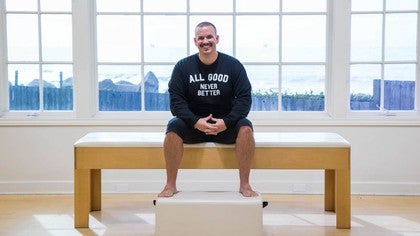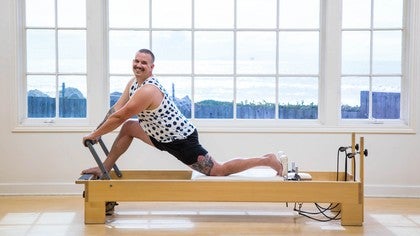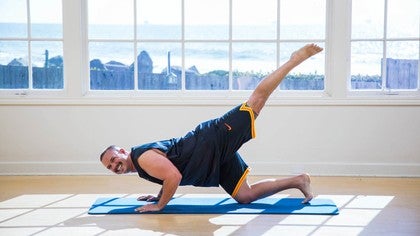Description
About This Video
Transcript
Read Full Transcript
Welcome back everybody. Uh, I'm James crater and we're going to do a mat class. Uh, again, this is uh, the third installment of the three part series. We have the meditation, we have the reformer class. Go back and watch those. It's gonna inform you a lot about what it is we're actually doing. We're on this third portion now, mat class and I think of this as self organization and a humanness class.
So, uh, I have a mat out here. We're going to be on the mat for X amount of time, but we're actually going to be off the mat for a good portion of the time. I also have a little blow up ball here, uh, kind of blown up, kinda not really blown up and we're going to start there. So I'm going to start on the mat and I'm going to place this ball underneath the pelvis, wherever it feels natural for it to go. So here I am underneath the pelvis and I'm just going to start just breathing sitz bones wide, soft belly, couple of nice deep inhales.
Let the sun kind of settle in. And from there I'm going to just let my right hip sink down and then I'm going to bring it back to center and I'm going to let my left hip sink down and bring it back to center. At first you can allow your knees to go whatever feels good for you to do and then begin to make some decisions. The decision I'm gonna make is, well here on my feet, my feet are going to stay grounded and I'm just going to let this move. My pelvis is nice and wide feeling and then from there I'm going to change my mind. I'm going to let the tailbone sink and then the tailbone lift.
It's just a little bit of a posterior and anterior pelvic rotation, a little bit of low back arch and picking it up. And then what if we bring that all together and let my tailbone sink? I travel over to the right into my lower spine over and just keep moving at some point and I can reverse at some point I'm going to go, well, what would feel good right now is to let more of my body begin to move so I can let my head respond to the pelvic movement and vice versa. On the mat. We're sort of in this open environment. It can go a little side to side. Again, we're in this open environment where I'm making decisions for my body, self organizing with gravity. The reformer class we did something very similar, allowed you the opportunity to be a little more held, get a little more information about this. This is just way more open.
At some point, I can allow my arm to begin to move and I can, my hands, I could lift up and just organizing and moving through my body. Now from here, I'm going to allow my arms to open up somewhere in the vein of a letter T and I'm going to take my legs up and I'm just going to begin to drop right and left. I can get a little snaky or I could get really linear side to side, and I'm going to explore going to the left and going to the right. Now, this is the beginning of falling practice. So as I go to the right, I'm going to brace my fall by allowing my right knee to open up and then come down. Coming up, just come up over to the left, left knee can come down. As you get more confident, I'm just going to make some decisions of rebounding and sinking into gravity and I can let my whole body make some choices. What does it feel like to let your arm move with that or your arm? Move this way, or maybe it's the opposite arm moving.
That feels really good.
I like to come off the mat cause I feel the mat is too sticky for this. And the floor just for me works better. Uh, from here, visualization really helps. This to me is now not a ball. What this is is a paint ball. So we're going to imagine that this paint ball is going to end up covering the majority of our body. And we're going to go from there. Uh, this is great for appropriate reception and for waking up what's called the humunculus map or your brain's registry of, well, how big is my body? Where is my body?
So I'm going to start with this somewhere on the ribs and I'm just going to imagine this is going to get loud. I'm going to imagine that this paint just paints the back of my ribs and there's no decisions to be made other than just move. So from here I'm just going to move and maybe I even paint all the way into my hand and paint all the way back around. And all the way into this hand, I can switch and go Palm up and get this moving all the way around coming up. The only rule is that I got to let my body do the painting versus move the ball.
Do this very tactful thing. It's a chance for you to get some really organic human movements and a chance for you to sort of roll around on the ground. And what if he even begins to paint my head and my neck all the way into my chest, painting the chest all the way back through, all the way into my low back, all the way through
Getting this to move however it is you want it to move to make it more difficult, make a fist and get through that. It can become some shoulder movement. I can turn my head away from it. Let my spine begin to move. As I do that, can I allow my sits bones to be wide and my spine to sort of just move however it wants to move. Switching sides, just kind of waking up and mobilizing the ability of my hand to find and move the ball. If you followed the rest of the videos, you know my left side is my, um, would be a thoughtful word. Here is my, uh, side that needs a little more tender loving care. We'll just say that
From there, bringing the souls of your feet together sits bones wide. You can be on the floor or you can come back to your mat. Your decision so here sits bones are wide, feet are together and I'm just going to rock right sit bone to left sit bone. As I do that, can I allow my spine to begin to move? I call this next exercise seaweed spine and how appropriate that we're in the location we are so imagining that my spine is seaweed and it there's no rhyme or reason to the way that it's going to move. It's just going to move from there.
I can make a different decision and the wave could come from behind me and I'm just allowing that to happen. I can change the orientation of my leg and reaching for that and coming back, changing it again and I'm just taking all of that mobilization work that we did in the spine and the pelvis and now we're just making it make sense for a more seated upright orientation.
If we then go, well, can my eyes track stuff around the room and as I do that, can I allow the legs to switch? Knowing that I can always come back to the sitz bones, I can always come back to just the seated thing or I can make it big. If you find that the hip joints are sort of the stymieing point, we'll go here, flex your feet, put your hands behind you and just let your knees drop to the other side so my feet don't move. They are where they are, which is different than I pick my feet up and I move. Feed are going to stay here. Knees flip flop. As you go through that, you'll notice that the spine is also asked to move.
There's a cat and a cow scenario that has to go on taking it easy first. We're just going to rely on some arms to help us out. And then maybe just one arm
Just allowing the spine to move. Then we're going to play with what happens if I wait, shift backwards and then weight shift forward.
It's going to be really difficult to hear. So you're going to see me put my head up. Feel free to put your head down. So from here, we're just going to be here for a moment, allowing the sitz bones to go wide. From there, I'm gonna make the decision to take my left leg out to the left with a knee bend and then go right back. And then my right leg and right back. What we're going to watch out for is as my left leg goes out to the side that my left hip doesn't have to lift, that my back doesn't have to do an adjustment here and that it's truly just to the best of my ability today, a leg moving out to the side. Now this is what my body looks like doing it to the best of my ability today.
Yours might be here and that's totally okay. Go where you can go with your leg. Just doing the work rather than the whole body having to bend and twist. I'm going to take it out here and come back. Take it out here, come back. Then I'm going to make the decision to stop flexing my foot.
We're going to do some hip mobility work here. I am relaxing, my deli sits bones wide and I'm going to make the decision to keep my knee down, lift my foot
Foot lift and down knee. Oh, that side is hard today. Foot lift. Let's see if I can organize this better.
It's not going one more
I can go left off right off, left on right on, right off, left off, right on, left on. Both off. Both on, both off, both on. Then just make some decisions where you want to look. What if I looked to the left and turn both of them off? Both of them on to the right. What if I looked for my own belly button, we're up and behind me and then play a little game with it. Making your own decisions as to what shoulders go on, what shoulders go off and where do I want to look?
I'm going to bring one leg out to the side as I did before and in order to get that leg underneath me, my shoulders need to do some work and I need to go through a cat experience right back out, right back out. Left knee wants to come underneath me. It has to be a cat right back out, right back out, right
In order to bring the other knee forward, I'm going to come up onto hands and knees right back out, all the way out, all the way out. Right side comes in to step forward. Out. Out. Here we go. And again, I could do that all day long, but let's move on. Coming back to the mat, coming up onto hands and knees.
Now we've done quite a bit of wrist mobility work, spinal mobility work, hip mobility work, so let's make it all happen here. Coming forward into my wrists. Backwards, forward, backwards to the right to the left. What if my eyes looked to the right and I was drawn to whatever I'm looking at to the left, to the right, to the left. Switch my vision and reverse one more and coming down. Just doing a little wiggle side to side and then making the decision to go, well, what if my hands when symmetrical or the other way?
Bring it back. Other side. Now here's where it talks of negative and positive compensation come in. Negative compensation is I get stuck here and so in order to make it work, I just do something that hurts me. Positive compensation is I go here and I follow my instinct to go, well, what if I just lift this arm to get there? One feels good. One doesn't
Proper finger tips. Stay down or whole hand.
Bring it back. Left leg all the way out. Sit into it, cat. Reach. Shoulders on cat. Reach, shoulders on. You can stay there. You can make it real fancy. Cat reach. Sit. Hand goes back. Back. Leg comes here. Hand goes down. We're still reaching that same leg. Come back. Let's do that one again. Right leg underneath reaches forward.
Sitting down. Left leg also reaches here I am left knee bins both hands down cat. There I am. Left leg reach.
Right leg reach.
I am back and forth. Back into that
From there, let's come back here and just kind of playing with that seaweed spine again. Let's go into some falling practice.
Lift your feet into a pushup.
Back into forward and back. So I've got five toes on each foot talking to five fingers on each hand and we're just back and forth. Maybe one foot or both feet. At some point it can become a squat and then up from there. Let's continue with this squat idea. When I tell students to do squats, it often looks something like this. Totally great. That is definitely one version. Now for me, I go a little wide. I go a little rotated and squat to me as a rest position.
So I go down and then I come back up. Yours will look different, but I'm down and I'm back up in order to get there, let's organize it a bit. So I'm going to go down and I'm going to just sort of look forward. Let my back line get real strong. Weight shift, toes, weight shift, heal in order to come up. I'm going to just think hips go forward in order to go down, hips go back, hips go forward, hips go back. I can change where my feet go. I can change where my arms go and kind of play with it. The reason that's important is when we get here to something like a walk. It's playing with weight, shifting forward, weight shifting back and my toes.
I'm in my heels. So just kind of playing with what does that feel like to move forward, to move back. Now with that as I weight shift, going to let the other leg just find its way forward and back. Can the spine move? My eyes move
Because really when it comes to something like gate is our right way to do gate or is gate and an expression of how I feel and do I feel open? Do I feel closed? It depends. In the studio I say, well if you won the lottery, think about how you'd walk into the room. If your best friend passed away, think about how you'd walk into the room. Which way is right? So as I move, how do I feel? I feel open. Do I feel closed? Can I go back into my meditation playing with gravity?
Can I start to play with Heights?
Is this a display of balance or is this, it depends. What is balance? To me, balance is the emergent property of vestibular system, eyes, interoception, proprioception. What is my body sensing in space? If I've made a three tiered birthday cake and I'm carrying it up a flight of stairs, I hope to have access to this. If Oh, I'll get along and I step on an acorn. I better hope I have access to this. Both of them are balance. So think about as you go to move and play here in a moment, which balance am I displaying? Is it rigid and stiff?
Cause I think that's what balance is. Or am I responding to gravity and the environment allowing my body to do the human thing. Now we started off with a ball and we're going to finish with a ball. I'm going to take a little bit of the weight out only because it's really hard to catch a full ball on air. So at the studio, fill it up, play with it. At my studio we play with hacky sacks, we play with different balls to um, emphasize different grips. Cause we started off with this and we've been using this, this is what we're going to use and we're just to start off tossing it.
I think play is an undervalued teaching tool. It's an undervalued exercise modality. And that's what we're going to do right now is play a little bit hand eye coordination, flexibility, training, balance training. So you're just tossing it. Then what if you picked one hand to toss and catch? You can be safe with it. You can be risky.
You can move around the space with it. You can change hands, you can change levels, but you got to use your eyes to track hands, have to know where they are. Body has to be open and available.
What if we tossed this and had to hit it with the knee
There's a little more risk involved, a little more energy involved in that. And what if that had to bring one foot off the ground?
Play in my book is really important to daily life. It's how we come together socially. And it really from a vagal nerve perspective begins to invite in my fight or flight, my risk taking and my social engagement systems. Meaning how safe do I feel in environments and we're just creating more and more options of where you feel safe playing with hand-eye coordination. And if you've got a kid, a partner, a friend, a fellow student to play with, all the better. Now we're creating community.
So hopefully you enjoyed these classes. Hopefully the through line was apparent to you. How the meditation opens us up. The reformer cultivates a sense of awareness and the mat work can allow us the space to self organize and play. Thank you so much for joining me. I'm James crater. Take out a ball. Get on the floor, roll around, toss it, have fun. Thank you so much for joining me.
Mindful Movement: Centering Exploration
Comments
You need to be a subscriber to post a comment.
Please Log In or Create an Account to start your free trial.




















